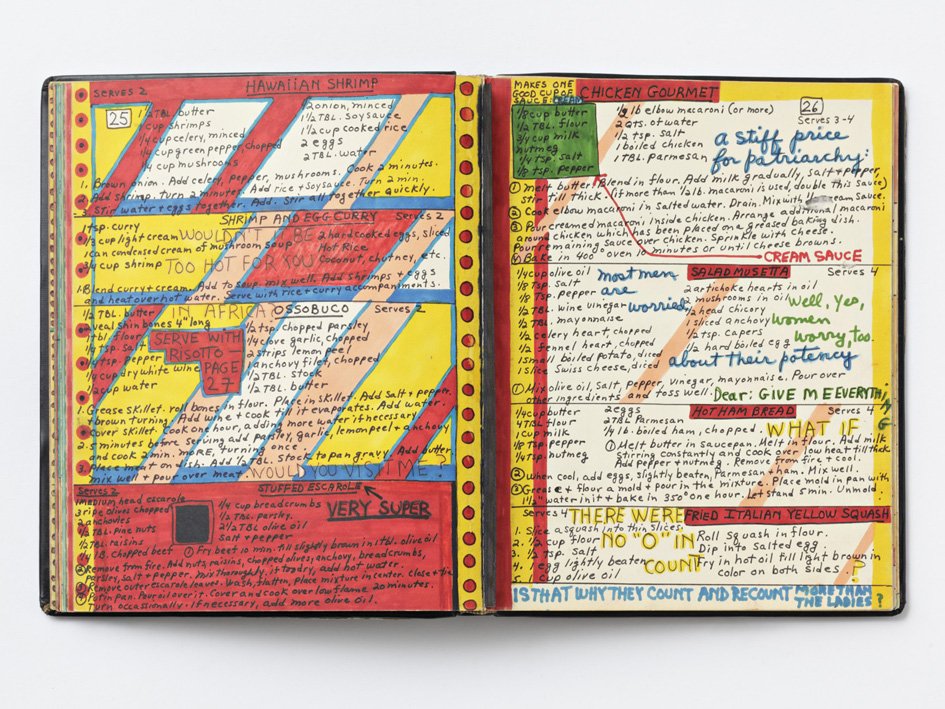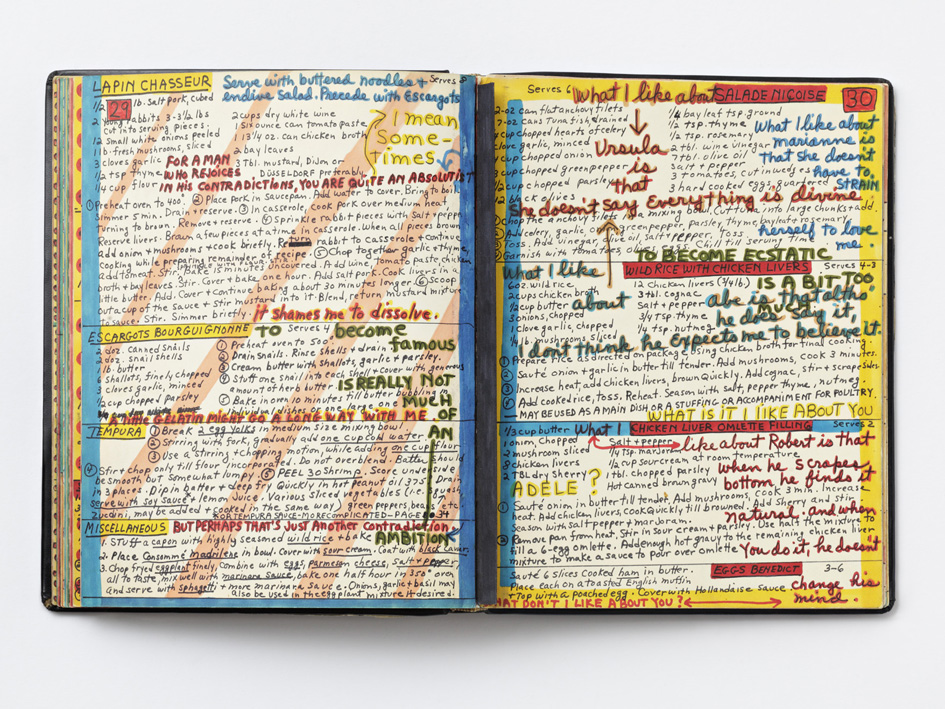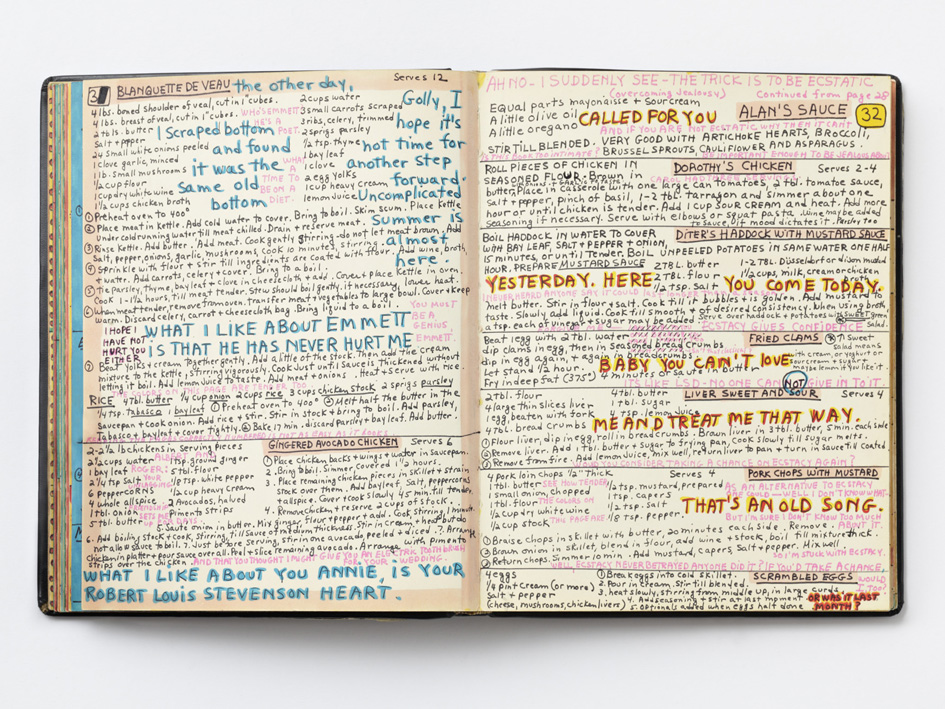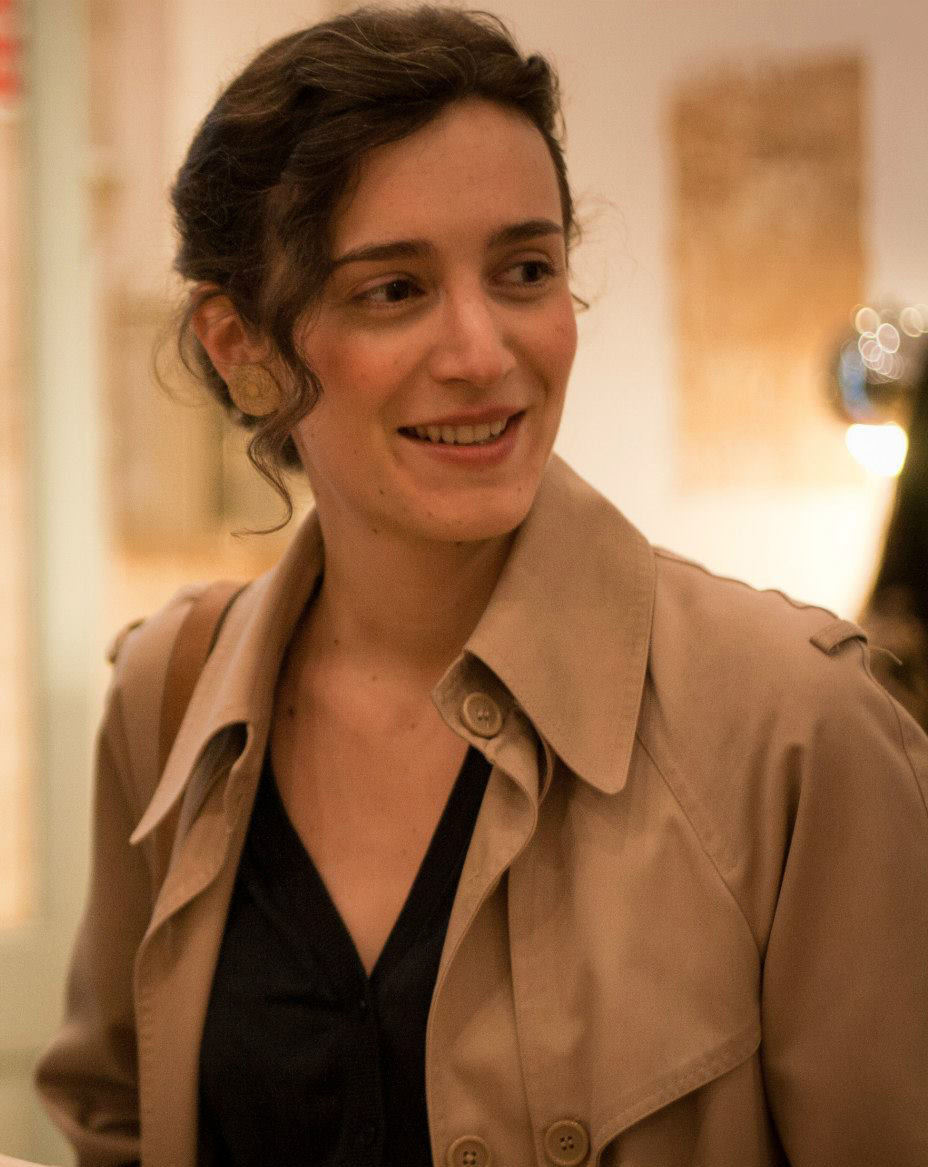Alice Waters, chef and co-founder of the famous Californian slow food restaurant Chez Panisse, summed up the close connection between art and cooking: “...they are both reactive and creative, imitating and adapting to each other.” So is there a connection between what happens in the studios of artists and what happens in their kitchens? Are there references to their work and personality? Are artists particularly creative when it comes to the everyday act of cooking? With the help of anecdotes and photos about their kitchens and eating habits, we provide insights into the culinary worlds of well-known artists.
In 1968 and at the age of 35, Dorothy Iannone began to write down her favorite meals and their recipes. When she had finished one year later the whole thing had grown into a book with over 60 pages and 200 dishes that she called “A Cookbook”. However, Iannone is not a cook, but rather an artist, and her book is not an ordinary cookbook either. For example, if you look up how to make gnocchi – featured on page 8 – you see alongside the recipe written neatly on a red and white background the drawing of a naked woman in yellow whose sex, not unlike a gnocco, is in the list of ingredients for Mussels with Tomato Sauce. “Just 3 bottles of wine can really loosen my tongue,” is written on her face, “Sometimes I have so many different pains, I become assured there can be nothing wrong with me,” you read at navel height. This juxtaposition of pragmatic cooking instructions and personal, often humorous, ironic reflections surrounded by floral and abstract ornament runs through the entire book. “A Cookbook” is a collection of recipes, a diary and a sketchbook, crammed with references to Iannone’s life and creative work.
Just 3 bottles of wine can really loosen my tongue.


Dorothy Iannone, A Cookbook (Detail), 1969, Image via airdeparis.com
Based on a four-course meal, selected to suit the artist’s own taste we undertake a short journey involving the most important steps in her career. All the recipes are from “A Cookbook” and are true to the originals.
Appetizers
Born in 1933 in Boston, Massachusetts, she grew up in an Italo-American household spanning several generations – her grandparents were immigrants from Calabria – and Dorothy Iannone thus came into contact with Italian cuisine at an early age. “I think maybe I like Italian food best of all. Is that bad?” she asks at the end of the book where the instructions for how to make “Cannelloni”, “Ravioli Bardelli”, “Stuffed Tufoli” and “Fettucine Alfredo” are given. Logically enough she includes dozens of classic South Italian dishes in her collection including this stuffed escarole salad alongside which she writes the words “very super”:
Stuffed Escarole
Serves 2
1 MEDIUM head escarole
3 ripe olives chopped
2 anchovies
1/2 TBL. pine nuts
1/2 TBL. raisins
1/4 lB chopped beef
1/4 cup breadcrumbs
1/2 TBL. parsley
2 1/2 TBL. olive oil
salt + pepper
1. Fry beef 10 min. till slightly brown in 1 tbl. olive oil
2. Remove from fire. Add nuts, raisins, chopped olives, anchovy, breadcrumbs, parsley, salt + pepper. Mix thoroughly. If too dry, add hot water.
3. Remove outer escarole leaves. Wash, flatten, place mixture in center. Close + tie.
4. Put in pan. Pour oil over it. Cover and cook on low flame 20 minutes. Turn occasionally. If necessary, add more olive oil.
very super

Dorothy Iannone, A Cookbook (Detail), 1969, Image via airdeparis.com
Starters
Initially Iannone studied American Literature and only became interested in art as an autodidact after she married artist James Upham in 1958 and moved with him to New York. Her first artistic works are images and collages in the Abstract Expressionist mold but then the couple travels extensively to Europe and Asia and her work becomes increasingly more figurative. Iannone integrated elements of Indian temple art, Japanese woodblock prints, Greek vases and Byzantine mosaic work into her compositions. The early works also include the first human figures with prominent sexual organs that become a signature feature of her later oeuvre. Thematically, the artist becomes more and more interested in the central issue of exploring sensuality and love. During a longer stay in Southern France Iannone developed close friendships to artists from the Fluxus movement and from a culinary perspective this stay also leaves it mark: While only a handful of dishes including pilau, tempura and Peking Duck recall her trips to Asia, the French cuisine takes up a lot of space in Iannone’s artist cookbook. Under the letter “C” alone you find “Cassoulet”, “Coq au Vin”, “Croûtes”, “Chicken Liver Canapé” and the following classic, luxurious dish that symbolizes Iannone’s cosmopolitan lifestyle with the wealthy Upham:

Dorothy Iannone, A Cookbook (Detail), 1969, Image via airdeparis.com
Consommé madrilène with sour cream and caviar
[This dish appears under “Miscellaneous" and is not accompanied by detailed instructions just by the following description:]
“Place Consommé Madrilène in bowl. Cover with sour cream. Coat with black caviar.”
Main course
1967 marked a key moment in Iannone’s biography: During a trip to Iceland, she got to know German-Swiss Concept artist Dieter Roth, fell in love and within the space of only a week abandoned her old life. Her relationship to Roth also marks the start of a new creative phase in the artist’s life characterized by her addressing the concept of “ecstatic unity" that she sees in the sexual merging of man and woman. Her own erotic experiences with Roth serve as the subject; to him she ascribes the dual role of lover and artistic muse. In the numerous artist books, sculptures, drawings and objects that Iannone produced in subsequent years she celebrates and draws a portrait of female sexuality in all its facets in a humorous, open manner. She develops a striking narrative style based on the interplay of images and words.
Though her move to Europe was a hasty one, Iannone was wise enough to not only take some of her artworks with her but also her cookbooks and spices. And indeed “A Cookbook” comes about out of Iannone’s motivation despite the many moves with Roth – they live during their seven-year relationship variously in Reykjavik, London, Basel and Düsseldorf – to create a sense of home by cooking her favorite dishes. When Iannone first sees her future partner in Reykjavik harbor he is holding a fresh fish in his hand wrapped in newspaper. Fittingly, the cookbook has a simple fish recipe that has Dieter’s name in its title and relies on mustard “Düsseldorfer Senf” to give it flavor – a classic dish from the regional capital where Iannone and Roth spend a lot of time together.
Diter’s Schellfisch mit Senfsauce
Boil haddock in water to cover with bay leaf, salt + pepper + onion, 15 minutes or until tender. Boil unpeeled potatoes in same water one half hour. Prepare mustard sauce:
2TBL. butter
2 TBL. flour
1/2 tsp. salt
1-2 TBL. Düsseldorf or Dijon mustard
1 1/2 cups milk, cream or chicken broth
Melt butter. Stir in flour + salt. Cook till it bubbles + is golden. Add mustard to taste. Slowly add liquid. Cook till smooth + of desired consistency. When using broth, a tsp. each of vinegar + sugar may be added. Serve over haddock + potatoes with sweet* green salad.
*Sweet salad means with cream, or yoghurt or sour cream + sugar + maybe lemon if you like it.

Dorothy Iannone, A Cookbook (Detail), 1969, Image via airdeparis.com
Desert
Iannone’s work fell prey to censorship on several occasions throughout her career owing to her representation of explicitly erotic situations. And she also experienced rejection on the part of members of the women’s movement in the 1970s as her understanding of free love as the complete mutual surrender of man and woman was not considered emancipated. However, she was not deterred at all by such sentiments. After she and Roth Split up in1974 Iannone received an artist scholarship from the German Academic Exchange Council and moved to Berlin. However, it was not until several years later that the art institutions express their explicit praise of her work: In 2009, when she was almost 80 years old, the New Museum in New York dedicated a solo exhibition to her works, and in 2014 Berlinische Galerie followed suit. Today, Iannone continues to work from the studio of her Berlin apartment on the next chapters of her artistic narration while she has meanwhile relocated “ecstatic unity” to her own inner self.
Dorothy Iannone has always celebrated the acting out of lust and sensuality, and it is therefore fitting that the crowning glory of the meal is an uncompromising sweet biscuit desert from Italy with crème de cacao, whipped cream, strawberries, vanilla and rum.
Zuppa Inglese
1/2 cup granulated sugar
1/4 cup flour
1/4 tsp. salt
2 cups scalded milk
4 egg yolks
1/2 cup light rum
1/2 tsp. vanilla extract
2. TBl. crème de cacao
2 sponge layers
1 cup heavy cream whipped
1 pint fresh strawberries
2 sliced fresh peaches (optional)
1. Mix sugar, flour + salt in top of double boiler. Add milk gradually, stirring. Cook stirring, over boiling water, until thickened.
2. Beat egg yolks until blended. Gradually add part of the milk mixture to the yolks, while stirring. Return to the hot mixture and cook over simmering water, stirring constantly, until thickened. Cool and chill.
3. Divide the mixture into three parts. Add one tbl. rum to one part, the vanilla to the second and the crème de cacao to the third.
4. Split the sponge cake layers to make 4 layers and place on a serving plate. Sprinkle with 1/4 of the remaining rum and spread with one of the 3 custard mixtures. Repeat with the 2nd and 3rd layers. Cover with the fourth layer of cake and sprinkle it with the remaining rum. Chill overnight in the refrigerator.
5. At serving time spread whipped cream over the top and sides of the cake and arrange berries + peaches on cream.

Dorothy Iannone, A Cookbook (Detail), 1969, Image via airdeparis.com

Dorothy Iannone, A Cookbook (Detail), 1969, Image via airdeparis.com
